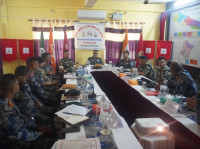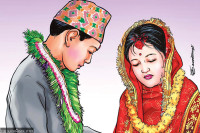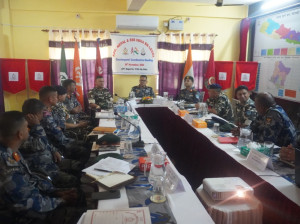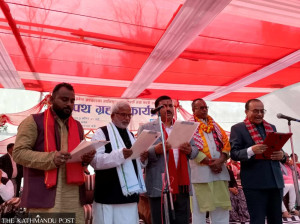Madhesh Province
Embankments destroyed in floods in Province 2 are being filled with sandbags that are not strong enough to contain water
Flood wary districts in the province face the same ordeal every year but the authorities are yet to find a permanent solution to this perennial problem.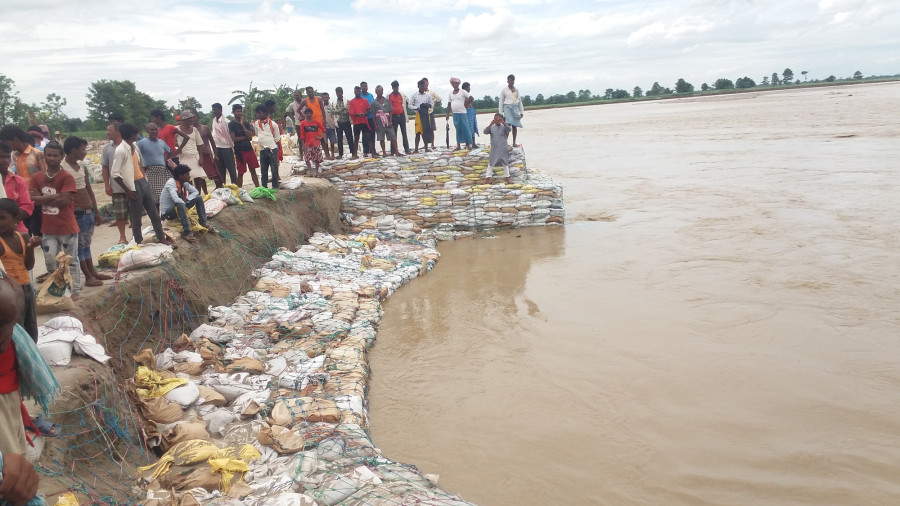
Om Prakash Thakur
The mid-July floods brought on havoc across the Tarai. In the most-affected districts of Rautahat, Sarlahi, Mahottari, Dhanusha and Sarlahi, rain-swollen rivers tore through embankments and engulfed settlements, displacing hundreds of households, destroying hundreds of hectares of agricultural lands and killing around a dozen people.
The decades-old embankments built across Bagmati, Bakaiya, Ratu and Kamala Rivers were not strong enough to contain the raging waters of the rivers. And as soon as the flood waters receded, the local units rushed to spend money out of state coffers to rebuild the embankments, but without much thought, locals say.
Local units and the Office of Water Induced Disasters (WIDC) hastily started filling the broken embankments with sandbags. The move, however, has been criticised not only by the survivors but even by government technicians, who say that the efforts are unsustainable.
Most of the embankments that were eroded are as old as 40 years. Locals and technicians say the structures were sub-par and had flawed designs, even when they were built. The locals have been calling it out and demanding the structures be rebuilt entirely. But the local units have been continuing with the age-old method, like they did the previous years, saying they lack the funds for a complete overhaul.
Devanand Mahto, mayor of the Barahathawa Municipality in Sarlahi, said that neither the WIDC nor the People’s Embankment Programme has provided any support even after repeated calls for attention.
Last year, the Barahathawa Municipality decided to go its own way to contain the rivers, constructing two “breakers”, spending Rs 6 million. “That was what we could do,” Mahto said. But only two breakers can’t contain a river, so the erosion continues. “We can do only so much with the municipality’s budget,” Mahto added. “We informed the Minister of Water Resources as well but nothing significant has been done so far.”
Even though the floods have settled, the rivers have continued to erode arable fields. Short of options, locals too have joined efforts of local units and WIDC to contain the water using sandbags to fill the embankments. With these lackadaisical measures, it is sure that the floods will create the same havoc next year.
Ratna Bahadur Giri, chief of ward number 1 in Barahathawa Municipality, said that dozens of settlements in his municipality and Ramnagar Rural Municipality are at immediate risk of floods caused by erosion. “The river has already destroyed crops planted in hundreds of hectares of land,” Giri said. “If not contained, it will sure destroy more and also inundate dozens of settlements.”
Mayor Mahto said that his office had called the attention of Disaster Management Committee (DMC) after requests to WIDC and People’s Embankment Programme went unheeded. A team led by Chief District Officer of Sarlahi Mohan Bahadur GC, who also chairs the DMC, and the chief of WIDC Bara, Rajkumar Shrivastav, came for inspection. CDO GC called a team of technicians and directed them to study the crisis. And that is all that has happened thus far.
Shrivastav has not been picking calls anymore, Mahto said. “It’s the same story every year,” Mahto added.
The Post reached out to CDO GC who had been to the Bagmati River for inspection. “A long-term solution requires a heavy budget, beyond our capacity,” GC told the Post. “But we have been making efforts towards that. The sustainable solution may take some time, but the short-term efforts to contain the water are currently ongoing.”
The short-term efforts GC talks about are the same sub-par efforts to fill the embankments with sandbags and bamboo, which is what is currently happening at several river banks.
The floods not only inundate the settlements but also damage motorable bridges and roads. The bridge over Bhabsi River, for instance, was damaged by the floods three years ago. The bridge was repaired but this year again, the bridge is rendered unmotorable.
Manoj Kumar Chaudhary, chair of Janakpur Zonal Transportation Entrepreneurs’ Association, said that the floods have rendered several transportation labourers unemployed. “It happens every year but the government never seeks a permanent solution,” Chaudhary said.
It is high time there are proper, sustainable measures to curb this yearly problem, said Bishweshwar Yadav, chair of Kamala River Victim’s Coordination Committee in Dhanusha.
Bhagwan Jha, chief of Water Resource and Irrigation Development Division Office in Dhanusha, admits the lack of permanent solutions to this perennial problem. “We have however initiated dialogues on plans for permanent solutions,” Jha said, adding that this year’s floods affected several irrigation projects such as Badh Irrigation Project, Amari and Balubaha.
In Siraha, the situation is more or less the same. Manohar Kumar Sah, chief of Kamala River Control Project, said that because monsoon is here for another month and a half, the Project has started constructing embankments with sandbags to control floods that has already affected settlements such as Paterwa, Malhaniya, Kharsolwa, Basbit, Belha and Marewa, among others.
“For immediate preservation efforts, we have filled the sacs with sand and bound them with ropes to construct embankments,” said Sah. “But this is only a temporary solution, which does not guarantee it controls the raging water.”
(Shyam Sundar Sashi in Janakpur and Bharat Jargha Magar in Siraha contributed reporting.)




 19.12°C Kathmandu
19.12°C Kathmandu



